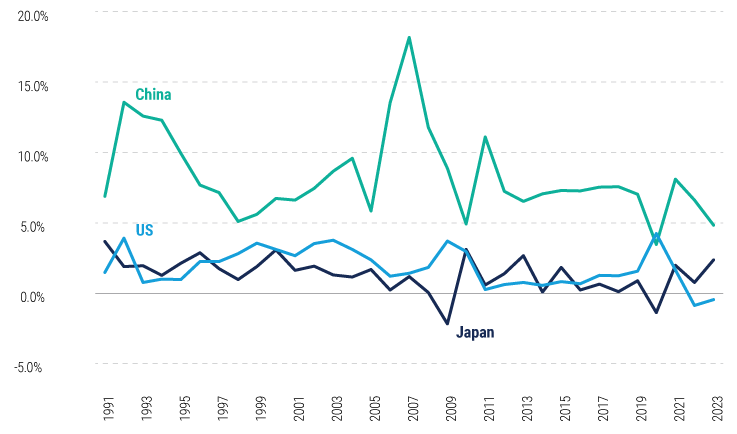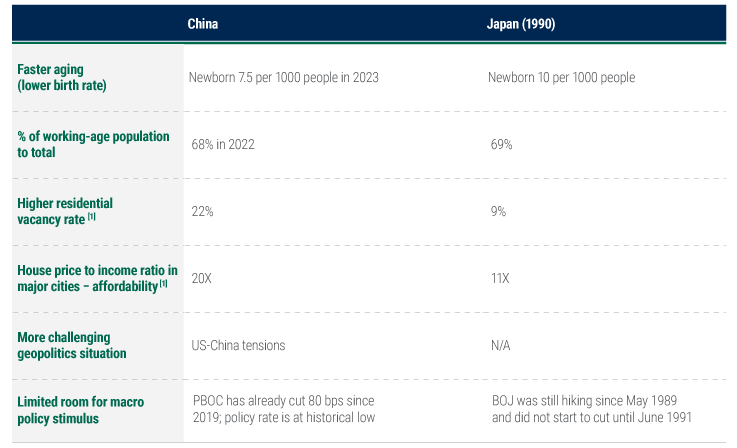In China, a ‘Japanification’ Scare But No Crisis

Samsara Wang
Asian Sovereign Analyst

Plenty of indicators suggest China is heading down a similar path to Japan in the 1990s – including deteriorating demographics, persistent low inflation, declining growth, and high debt levels, along with low consumer confidence and decreased private investment. “Japanification” is the label given to the economic phenomenon that transpired in that nation in the 1990s, when its economy fell into a deflationary trap of collapsed demand. This is also referred to as the Lost Decade or Lost Decades, as Japan still has not fully recovered from the initial burst even more than 25 years later.
There are a number of factors to consider, but with important differences – and we believe China will not repeat Japan’s mistake. Still, a lighter episode of Japanification may still occur in the absence of effective policy implementation.
Factors that make China more likely to see Japanification: a peaking population, higher residential vacancy rate, higher house prices, tighter property linkages to the economy, a more challenging geopolitical situation, and limited room for macro policy stimulus.
Factors that make China less likely to see Japanification – which we think carry more weight: a lower urbanization ratio, an abundant labor supply despite an aging population, an under- or fair-valued currency, less-stretched stock market valuations, a larger domestic market, limited damage to Chinese entities’ balance sheets resulting from the housing market correction, lower GDP per capita, and stronger bank balance sheets.
We see several key reasons why China will not go down the same road as Japan.
The root cause of slowing growth differs.
The current slowdown in China’s economy was mainly caused by 1) strict lockdowns during the pandemic; 2) unexpected government policy clampdowns on several key sectors, including technology, education, and (most importantly) property; and 3) US-China tensions. This suggests the slowdown is part of China’s painful process to diversify away from the traditional growth drivers of property and infrastructure investment to the new drivers of high-end manufacturing and self-reliance on high-tech sectors. Unfortunately, the pandemic hit at the same time. As for Japan, the Lost Decade was caused solely by asset bubble bursts in both the property market and the stock market. These bubbles were fueled by expansionary fiscal and monetary policies after the 1985 Plaza Accord. In order to fight high inflation and asset price speculation, the Bank of Japan was still hiking rates in May of 1989 and ultimately cut too late (in June of 1991).
China’s asset bubbles are not as large as Japan’s.
Before the burst in Japan, the Nikkei 225 was trading at 60x price/earnings, while the Shanghai Composite Index is only around 14x currently. Japan’s asset bubble bursts were also exacerbated by the strong yen exchange rate versus the US dollar. The yen appreciated around 45% against dollar from 1985 to 1990. Meanwhile in China, the yuan has depreciated 4.7% against the dollar during the past five years, partly driven by the trade-weighted US dollar, which appreciated by 8.6%.
The damage from the property price correction to Chinese banks and household balance sheets is much smaller.
The real estate price correction in China has occurred mainly in the residential property markets of low-tier cities, and we have seen local governments announcing support measures city-by-city, such as lowering downpayment requirements, relaxing the requirements of first-home mortgages, and loosening home purchase restrictions. Critically, no major financial institutions have failed. China banks’ non-performing loan ratio is also low, at 1.6% as of June 2023, down markedly from 12.4% in March 2005. For Japan, there was no Basel Capital Accord at the time. Japanese banks’ loans were overextended, especially in risky areas without adequate regulations. The economy’s slowdown and deflation soon led to surging non-performing loans. The failure of Toho Sogo Bank in 1991 was only the first, and failures of small financial institutions accelerated in 1994 and 1995. During the 1997 Asia financial crisis, major security houses collapsed.
China still has an abundant labor supply despite the peak in population growth – and the country will also enjoy healthy improvements in labor productivity over the medium term.
China’s government still has leeway to extend the retirement age limit, and the transfer of surplus labor from the rural sector to urban areas still has a lot of room to run. By our estimation, if the government increases the retirement age limit by five years, an additional 60 million to 67 million people will join the labor force, which is around 7% of the total working population. Currently, 24% of China’s total employment is in the agriculture sector, while this figure is below 5% in both Japan and the US (see chart). China’s labor productivity year-on-year growth is expected to stay high versus the US (currently) or Japan back in the 1990s, driven by continued improvements in education and training (see chart).
Agriculture Remains a Large Component of Chinese Employment
Employment in Agriculture, % of Total Employment

Source: PineBridge Investments, Macrobond as of end of 2021. For illustrative purposes only. We are not soliciting or recommending any action based on this material. Any views represent the opinion of the Investment Manager, are valid as of the date indicated, and are subject to change.
China’s Labor Productivity Will Likely Stay High vs. Japan and the US
China vs Japan Labor Productivity per Hour Worked, YoY

Source: PineBridge Investments, Macrobond as of June 2023. For illustrative purposes only. We are not soliciting or recommending any action based on this material. Any views represent the opinion of the Investment Manager, are valid as of the date indicated, and are subject to change.
Lastly, China’s risk of a debt crisis or a ‘fire sale’ is much smaller.
In China the government maintains strict oversight of the capital account and has strong control over both the asset and liability sides of the debt problem. These controls significantly lessen the probability of fire sales and an asset bubble burst.
Factors that make ‘Japanification’ in China more likely

Aspects that make ‘Japanification’ in China less likely

Sources: PineBridge Investments, Macrobond, Goldman Sachs Investment Research. For illustrative purposes only. We are not soliciting or recommending any action based on this material. Any views represent the opinion of the Investment Manager, are valid as of the date indicated, and are subject to change. 1Goldman Sachs estimation.
Cyclical and structural problems remain
While we don’t think China will fall into the Japanification trap, significant structural and cyclical challenges do remain. Growth will be on a moderate downward trajectory through the next two years at least, while inflation will remain subdued. This means that nominal rates will need to stay low to support the deleveraging campaign. While not our base case, we could see a “Japanification-lite” scenario play out if comprehensive policies are not adopted and successfully implemented over the medium term.
In our view, the top priority for China’s government is to revive the deeply scarred private sector’s confidence. This would aid the transition to a more diversified economy based on high-end manufacturing and consumption.
What we see as critical is a comprehensive package of policies that aims to boost the confidence of both the domestic private sector and foreign investors (including more effective communication of new policies and better coordination between government entities), manage the pace of deleveraging in local governments, and moves quickly to stabilize the property market.
Key investor takeaways
Amidst the complexities outlined above, volatility is likely to persist for China-related risk assets. However, China remains a significant and dynamic market offering opportunities for disciplined investors. By carefully navigating the landscape, staying informed, and leveraging a robust fundamental investment approach, we believe disciplined investors can uncover valuable investment opportunities within this evolving economic powerhouse.
Disclosure
Investing involves risk, including possible loss of principal. The information presented herein is for illustrative purposes only and should not be considered reflective of any particular security, strategy, or investment product. It represents a general assessment of the markets at a specific time and is not a guarantee of future performance results or market movement. This material does not constitute investment, financial, legal, tax, or other advice; investment research or a product of any research department; an offer to sell, or the solicitation of an offer to purchase any security or interest in a fund; or a recommendation for any investment product or strategy. PineBridge Investments is not soliciting or recommending any action based on information in this document. Any opinions, projections, or forward-looking statements expressed herein are solely those of the author, may differ from the views or opinions expressed by other areas of PineBridge Investments, and are only for general informational purposes as of the date indicated. Views may be based on third-party data that has not been independently verified. PineBridge Investments does not approve of or endorse any republication of this material. You are solely responsible for deciding whether any investment product or strategy is appropriate for you based upon your investment goals, financial situation and tolerance for risk.



